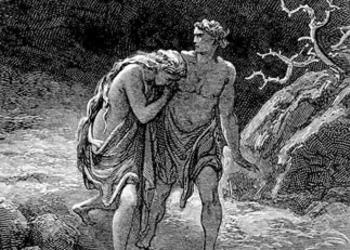Did Adam and Eve Really Exist?
Downloads
Did Adam and Eve Really Exist?

Certainly atheists and agnostics do. Many respected intellectuals and opinion makers in the media find themselves in the grip of evolutionary belief. They think they know better than God.
For instance, a recent headline in one of Britain's Sunday papers, The Observer, reads: "Dawkins and Attenborough Hail Victory Over Creationists." The drophead states, "Funding to be removed from free schools that teach 'intelligent design.'" The first paragraph of the text says, "Leading scientists and naturalists, including Professor Richard Dawkins and Sir David Attenborough, are claiming victory over the creationist movement after the [British] government last week ratified measures that will bar anti-evolution groups from teaching creationism in science classes" (Jan. 15, 2012).
But the Bible clearly teaches the existence of Adam and Eve—and not just in Genesis. The genealogy of Jesus Christ in Luke 3:23-38 goes all the way back to Adam. Adam's parent is designated as God in verse 38 since He was the one who created this first man.
Indeed the apostle Paul says that human beings are the offspring of God (Acts 17:28). He specifically names Adam as the first man (1 Corinthians 15:45, 47). Paul declared to Timothy that "Adam was formed first, then Eve" (1 Timothy 2:13). Earlier he had mentioned that "the serpent deceived Eve by his craftiness" (2 Corinthians 11:3). Jude tells us that Enoch was the seventh patriarch from Adam (Jude 14), as the genealogical account in Genesis 5 clearly shows.
Describing horrendous conditions during the time of the end, Jesus Christ plainly stated: "For in those days there will be tribulation, such as has not been since the beginning of the creation, which God created until this time, nor ever shall be" (Mark 13:19). Earlier, while upholding the marriage institution, Christ said, "From the beginning of the creation [of human beings], God 'made them male and female'" (Mark 10:6).
Christ based His teaching on marriage on the creation of Adam and Eve. Having made the first two human beings male and female, He continued: "For this reason a man shall leave His father and mother and be joined to his wife, 'and the two shall become one flesh' [quoting from Genesis]; so that they are no longer two, but one flesh. Therefore what God has joined together, let not man separate" (Mark 10:7-9).
The apostle Paul referred to Adam in stating that it was "through one man [that] sin entered the world [human society], and death through sin, and thus death spread to all men, because all sinned" (Romans 5:12). Yet Paul further explained that Adam was, in respects, a forerunner or type of Jesus Christ (verse 14). Summing up the rescue of the human race through this second Adam, Paul continued: "For if by one man's [Adam's] offense death reigned through the one, much more those who received abundance of grace and of the gift of righteousness will reign in life through the One, Jesus Christ" (verse 17).
Paul restates his teaching on the atonement in different ways. For instance, "For as by one man's disobedience many were made sinners, so also by one Man's [Christ's] obedience many will be made righteous" (verse 19).
It should be clear from all these scriptures that we cannot rationally separate the account in Genesis of Adam and Eve's creation by God from basic New Testament doctrine. The latter is deeply dependent on the former.
Both depend on our willingness to first prove and then accept the authenticity and authority of the Holy Scriptures—both the Old and New Testaments. To learn more, request or download our free booklet Is the Bible True?
